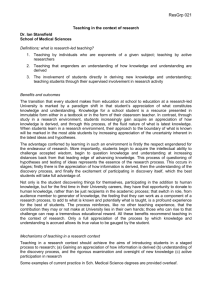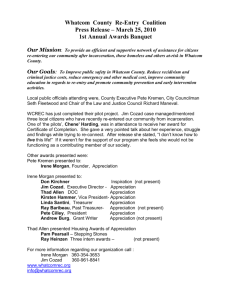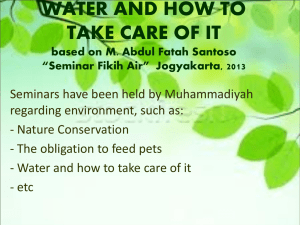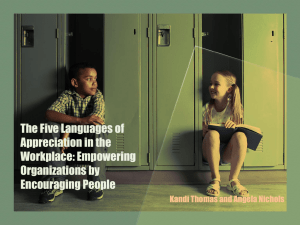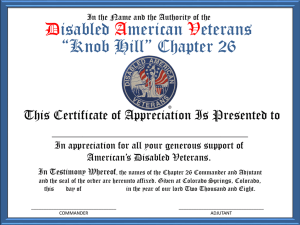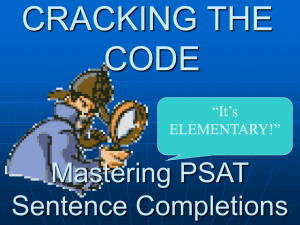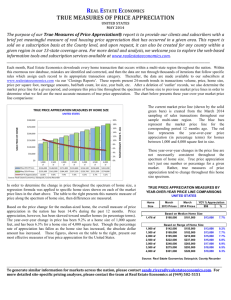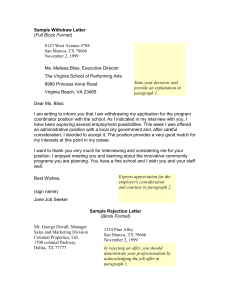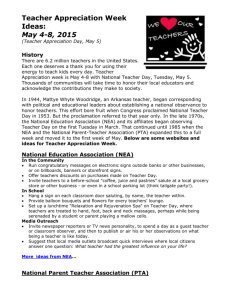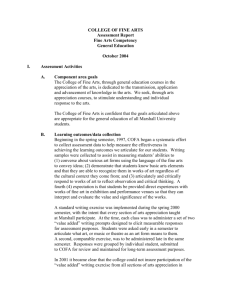Erin
advertisement
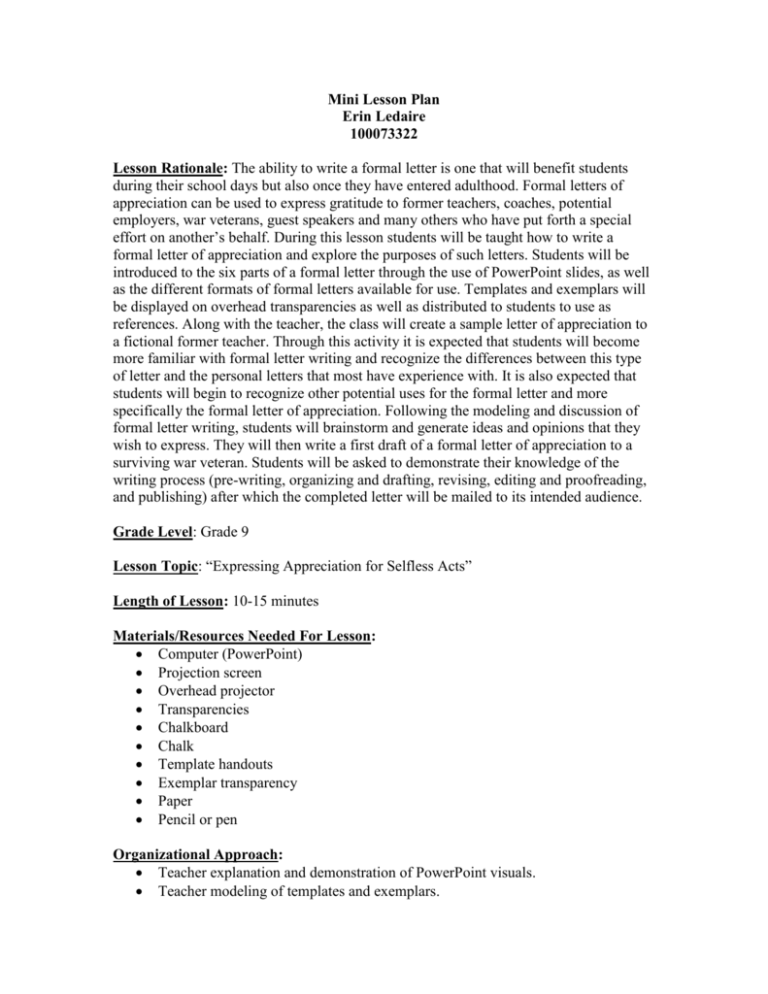
Mini Lesson Plan Erin Ledaire 100073322 Lesson Rationale: The ability to write a formal letter is one that will benefit students during their school days but also once they have entered adulthood. Formal letters of appreciation can be used to express gratitude to former teachers, coaches, potential employers, war veterans, guest speakers and many others who have put forth a special effort on another’s behalf. During this lesson students will be taught how to write a formal letter of appreciation and explore the purposes of such letters. Students will be introduced to the six parts of a formal letter through the use of PowerPoint slides, as well as the different formats of formal letters available for use. Templates and exemplars will be displayed on overhead transparencies as well as distributed to students to use as references. Along with the teacher, the class will create a sample letter of appreciation to a fictional former teacher. Through this activity it is expected that students will become more familiar with formal letter writing and recognize the differences between this type of letter and the personal letters that most have experience with. It is also expected that students will begin to recognize other potential uses for the formal letter and more specifically the formal letter of appreciation. Following the modeling and discussion of formal letter writing, students will brainstorm and generate ideas and opinions that they wish to express. They will then write a first draft of a formal letter of appreciation to a surviving war veteran. Students will be asked to demonstrate their knowledge of the writing process (pre-writing, organizing and drafting, revising, editing and proofreading, and publishing) after which the completed letter will be mailed to its intended audience. Grade Level: Grade 9 Lesson Topic: “Expressing Appreciation for Selfless Acts” Length of Lesson: 10-15 minutes Materials/Resources Needed For Lesson: Computer (PowerPoint) Projection screen Overhead projector Transparencies Chalkboard Chalk Template handouts Exemplar transparency Paper Pencil or pen Organizational Approach: Teacher explanation and demonstration of PowerPoint visuals. Teacher modeling of templates and exemplars. Class discussion of the differences between the formal letter and the personal letter, as well as the differences between the different formats of formal letters. Class examination of exemplars (Teacher will read the examples. They will also be displayed on the overhead projector). Class creation of a sample letter of appreciation on the chalkboard. Individual writing, revising and sharing. Step-by-Step Lesson Activities: The lesson will begin with the teacher asking students if they have ever written a formal letter or a letter of appreciation. If students in the class have experience with this type of writing they will be asked to share what they know with the class. Students will then view the PowerPoint slideshow which explains the different parts of a formal letter and gives instruction on how to compose a formal letter of appreciation. The slideshow also discusses the purposes of letters of appreciation. Students will be handed out templates of each of the three formal letter formats discussed. Students will be asked to explain the differences that they notice between the formal letter and personal letter that one would write to a friend or family member. The different uses of formal letters will also be discussed, as will the different possible uses for formal letters of appreciation. An example of a letter of appreciation will be read to students and displayed on the overhead projector. Together as a class, students will go through the process of writing a formal letter of appreciation to a fictional former teacher or coach. Students will then individually brainstorm and create a draft of a formal letter of appreciation addressed to a war veteran. This draft will then be revised, edited and proofread by students themselves and their peers in order to prepare this letter to be sent to its intended audience. The Formal Letter: Block Form Your Name Address Phone Number or Fax Number E-mail Address (optional) Date Name of Receiver Title Company Name Address Dear _________: Paragraph 1: Introductory text When writing a letter using block form, no lines are indented. Paragraph 2: Body Text Skip lines between paragraphs instead of indenting. Paragraph 3: Conclusion Sincerely, Your signature Your name (typed) Your title (if you have one) The Formal Letter: Indented Form Your Name Address Phone Number or Fax Number E-mail (optional) Date Name of Receiver Title Company Address Dear ______: When using indented form, each paragraph is indented. Your name, address, phone number, and the date should be located at the top of the page, either in the centre, or indented on the right side of the page. At the end of the paper, include your complimentary closing, and signature on the right-hand side of the page. Sincerely, Your Signature Your Name Your title The Formal Letter: Simplified Form Your Name Address Phone Number or Fax Number E-mail (optional) Date Name of Receiver Title Company Name Address SUBJECT LINE (use capitals) When writing a letter using simplified form, write a subject line instead of a salutation. The subject line must be in all capitals. At the end of the letter, write your name and title, all in capitals. YOUR NAME YOUR TITLE Example of a Letter of Appreciation (Block Form) John Doe 1019 Patterson Avenue Dartmouth, Nova Scotia B2K 1J3 October 29, 2004 Barbara Jones Supervisor, Canadian Red Cross 1122 Mountain Road, Halifax, Nova Scotia B4L 6W2 Dear Mrs. Jones: I would like to thank you so much for meeting with my class and answering our questions about your line of work. I learned many things about your philanthropic organization. I appreciate you taking the time out of your busy schedule to share your knowledge and experience with me and my class. One of the most important things I learned was how you send people all over the world to help others after a disaster. There are too many wonderful things that you do locally and nationally to mention. I am sure the many people your organization has helped will never forget it. I appreciate you and your colleagues’ hard work, and it makes me feel better to know that organizations like your exist should I or anyone I know experience the need for such aid. Thank you again for your dedication. Sincerely, Signature of John Doe John Doe

